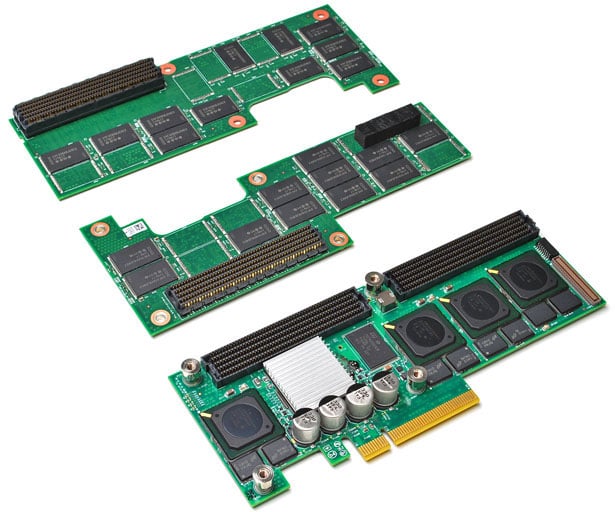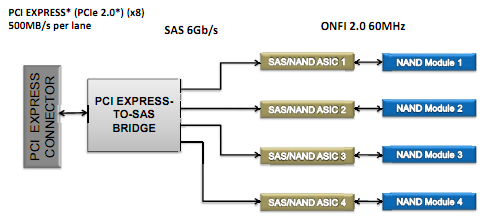Intel SSD 910 PCI Express SSD Performance Review
A Detailed Look at The Intel SSD 910
The Intel SSD 910 is a surprisingly elegant design. There are three PCBs that make up the half-height card that will likely fit cleanly into many low profile server designs. The card's width consumes only a single PCI Express slot, though it is a fairly dense design that requires adequate airflow.





Yes, we were crazy enough to tear down a $3800 SSD; verrrry carefully. Click for high res.

Intel SSD 910 High Level Architecture




In fact, Intel specifies a required 200 LFM (Linear Feet per Minute) air flow over the device with a 0 - 55ºC ambient operating temp range. In other words, you're not sandwiching this bad boy between two piping hot graphics cards or in a dense server configuration, without direct airflow pointing right at the card. 200 LFM isn't exorbitant (it's a fairly standard server airflow spec) but fair warning. Keep 'er cool.

Yes, we were crazy enough to tear down a $3800 SSD; verrrry carefully. Click for high res.

Intel SSD 910 High Level Architecture
The tear-down shot above (no worries, precious wasn't injured in the process) and the block diagram here give us a good idea of how the device is configured and how it operates. The 800GiB Intel SSD 910 we tested is made up of four SSD modules, 200GiB for each module, though they're populated across two PCBs, each with 448GB of Intel 25nm NAND per card (over-provisioned). Each of the SSD arrays is managed by a co-developed Intel-Hitachi SAS/NAND controller. Each of these controllers is a dual-core chip with its cores managing either the SAS or NAND interface. If you look closely, each of these controllers is also flanked with a pair of Micron DDR2 SDRAMs.
Then, providing a X8 Gen 2 PCI Express link to the card edge is an LSI 2008 (PDF) PCI Express to SAS bridge. This SATA/SAS controller (under the silver heat sink) has been on the market for some time with widespread driver support. At its heart is a 533MHz PowerPC 440 processor but unfortunately the Intel implementation doesn't offer hardware RAID support. In fact, each of the 200GiB SSD modules will present as a separate volume to the operating system. In addition, the SSD 910 is not bootable. You can, however, configure an 800GiB (or 400GiB for the lower capacity drive) software RAID 0 array with the card, so you can aggregate performance across all SSD controllers. This is the exact configuration we tested it in.
Speaking of which, let's fire it up...
Then, providing a X8 Gen 2 PCI Express link to the card edge is an LSI 2008 (PDF) PCI Express to SAS bridge. This SATA/SAS controller (under the silver heat sink) has been on the market for some time with widespread driver support. At its heart is a 533MHz PowerPC 440 processor but unfortunately the Intel implementation doesn't offer hardware RAID support. In fact, each of the 200GiB SSD modules will present as a separate volume to the operating system. In addition, the SSD 910 is not bootable. You can, however, configure an 800GiB (or 400GiB for the lower capacity drive) software RAID 0 array with the card, so you can aggregate performance across all SSD controllers. This is the exact configuration we tested it in.
Speaking of which, let's fire it up...






